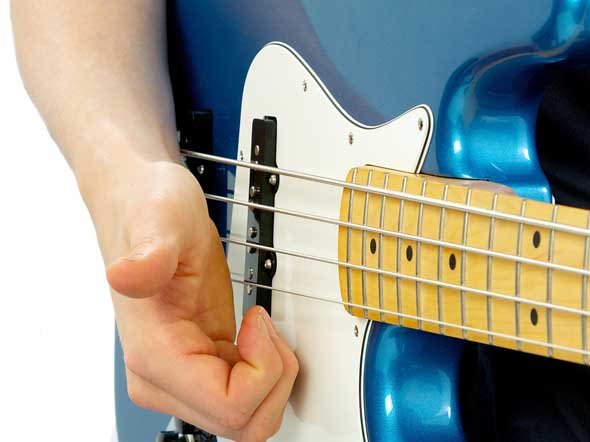
Slapping and Popping
Another important style of bass playing which is used in Funk, Rock and other related styles is the use of techniques which involve slapping with the right thumb and popping with the right hand fingers. The style is often just called slap. The best way to begin playing this style is to practice slapping the open strings with the side of the right thumb as demonstrated in example 78 and shown in the following photographs.
The best place to strike the string is right at the end of the fretboard. This allows for a bit of "give" in the string and also forces the string down onto the frets, thus producing the sound.
Make sure that you strike the string clearly and then let your thumb rebound up off the string like a drum stick rebounding off a drum. If you leave your thumb in contact with the string, it will deaden the sound and none of the notes will be clear.



Left Hand Damping
As you strike each string with the thumb, be sure to damp the other strings with your left hand by laying your fingers lightly across the strings. In slap playing, damping out the sounds you don’t want is as important as sounding the notes you do want. As you play all the examples in this lesson, listen carefully to your playing to make sure there are no unwanted notes ringing. If you do hear any, analyze which strings they are coming from and practice damping them out with your left hand.
Once you can play clear, even notes on the open strings without other unwanted strings ringing, try playing some scales and arpeggios using the slap technique. The following example moves around within the E Blues scale.

The next thing to do is to make up some bass lines using the slap technique. Here is an example.

It is also common to use ghost notes in conjunction with the slap technique, as shown in this example.

Popping Technique
Another important aspect of the slap style is the use of the finger popping technique. This technique is usually done with the index finger (i) but the middle finger (m) is also sometimes used. The technique is performed by putting the end of the finger slightly under the string and then pulling it upwards and away, allowing the string to snap back against the fretboard, thus producing the sound.
A combination of arm and wrist rotation is used to achieve this technique. Study the photos and practice this technique on the next exercise.



Slap and Pop Symbols
Most slap bass lines use a combination of slapping and popping. When using the slapping and popping techniques in the same line, it is necessary to use symbols above or below the notes to indicate which notes are slapped and which are popped. In general the lower notes are slapped and the higher notes are popped, but this is not always the case. It is common to use the letter T (indicating thumb) for slapped notes and the letter F for popped notes as shown in the following example.

Here are some bass lines which make use of the slapping and popping techniques. If you wish to study the slap style in detail, see Progressive Beginner Slap Bass .



